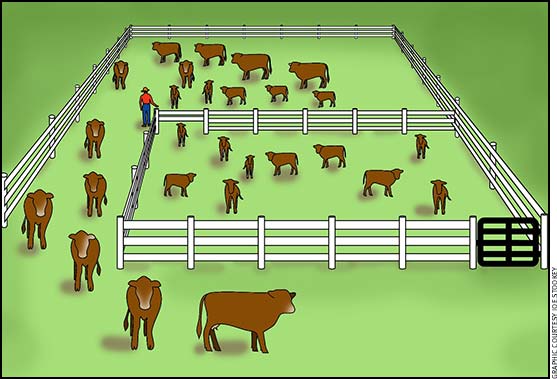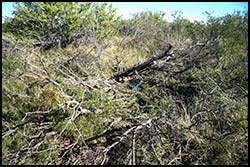MANAGEMENT...

Sorting Tip
A simple way to sort calves from cows.
Sorting calves away from cows for branding/vaccinating, artificial insemination (AI) protocols, preweaning vaccinations, weaning, etc., can be time-consuming. Some producers use an alley where cows are encouraged to go one way and calves another, but this takes at least two people, good swinging gates, and cattle sometimes bunch up in the sorting area when cows don’t want to leave their calves.
An innovative refinement of this idea allows natural movements of the animals to sort themselves. Joe Stookey, professor at Western College of Veterinary Medicine, Saskatoon, Sask., says that when cattle are put into a corral, their tendency is to turn around and come back out that gate. Read more.
Mob Grazing
A tool to improve pasture and increase stocking rate.
Short-duration, high-intensity grazing — many cattle on a small area of pasture, moved at least once a day or several times a day to a new section of pasture — is often called mob grazing. There are several interpretations of what mob grazing means.
Ian Mitchell-Innes is an educator certified in holistic management in South Africa who has been practicing these principles on his own ranch for 15 years. He presents talks and courses on the subject around the world. He defines mob grazing as getting animals to move through a pasture at high stock density to emulate the predator-prey relationship, which was the major factor influencing grazing behavior of herds before humans imposed their own management systems on domesticated ruminants. Read more.

Kris Ringwall
Beef Talk
The plow and cow are strange companions.
The world of beef cattle, at least for some, is good and so are profits. The cow-calf enterprise is making money for those who are in the upper 40% of gross margins minus direct and overhead expenses.
What is nice is that the cow-calf enterprise for those upper 40% of producers is contributing in a positive manner to labor and management. Cattle numbers, when return to labor and management is positive, will expand. However, the cow-calf business seems to be in a “wait and see” mode with many conflicting thoughts. Given the positive position for those producers who are financially successful, the cow-calf business should expand. Read more.
Refill the Aquifer
Texas A&M researchers determine best range management practices
for aquifer recharge.
 Water recharge to an aquifer is highly dependent on vegetation and soil type, but what are the best management practices for landowners to ensure maximum environmental returns and economical livestock and wildlife production?
Water recharge to an aquifer is highly dependent on vegetation and soil type, but what are the best management practices for landowners to ensure maximum environmental returns and economical livestock and wildlife production?
Team members from Texas A&M University’s ecosystem science and management department and the Texas A&M AgriLife Extension Service are working to answer that question with the “Effects of Brush Removal on Distributed Recharge of the Carrizo‐Wilcox Aquifer” project, funded by the Wintergarden Groundwater Conservation District. Read more.
Farmers See Tax Changes In
Annual Reporting In 2012
Farms will see several changes that will impact when and
how they report 2012 income taxes.
The fiscal cliff created the opportunity for a number of changes in the tax rules regulating when a farm must complete and file their annual income tax returns. For 2012, farm income tax returns have received a deadline extension from the normal March 1, 2013, date to file their tax returns without penalty if they have not made estimates. With the tax deadline extended, farm producers now have until April 15, 2013, to file their tax returns without a penalty.
Farms that elect to delay completing and filing their tax returns after March 1, 2013, will need to include a Form 2110F as part of their returns. Read more.
Facts About Ag Odors, Emissions
Videos on animal agriculture odors and airborne emissions provide science-based information.
Videos to help owners and managers of animal feeding operations, their neighbors, elected officials, policy makers and interested community members discuss and find useful science-based information and resources about odors and airborne emissions from the feeding operations are available online through eXtension.
Good information helps people make informed decisions. Producers and managers of livestock and poultry operations need information to understand how their practices affect odor and gas emissions from their facilities and the impacts those emissions have on their neighbors and community. Producers, their neighbors, elected officials and policy makers need information to help them balance the concerns and needs of the community and the men and women who own and operate animal-feeding operations. Read more.
Angus Advisor
Click here for April herd management tips from cattle experts across the nation. Advice separated by region.
[Click here to go to the top of the page.]











